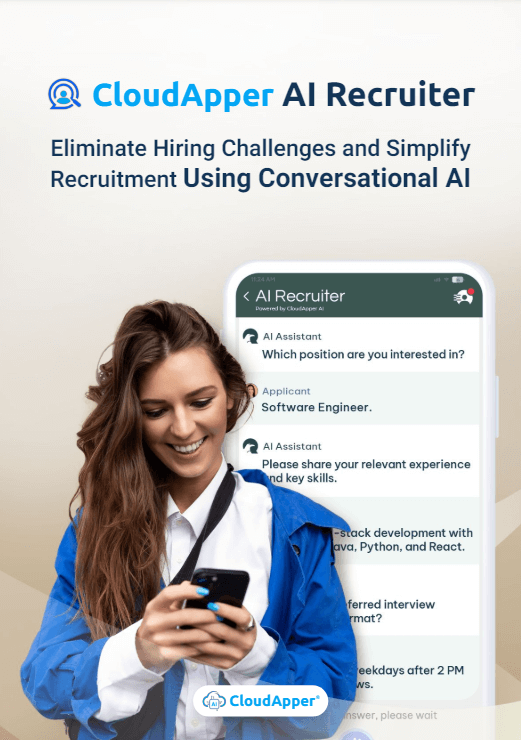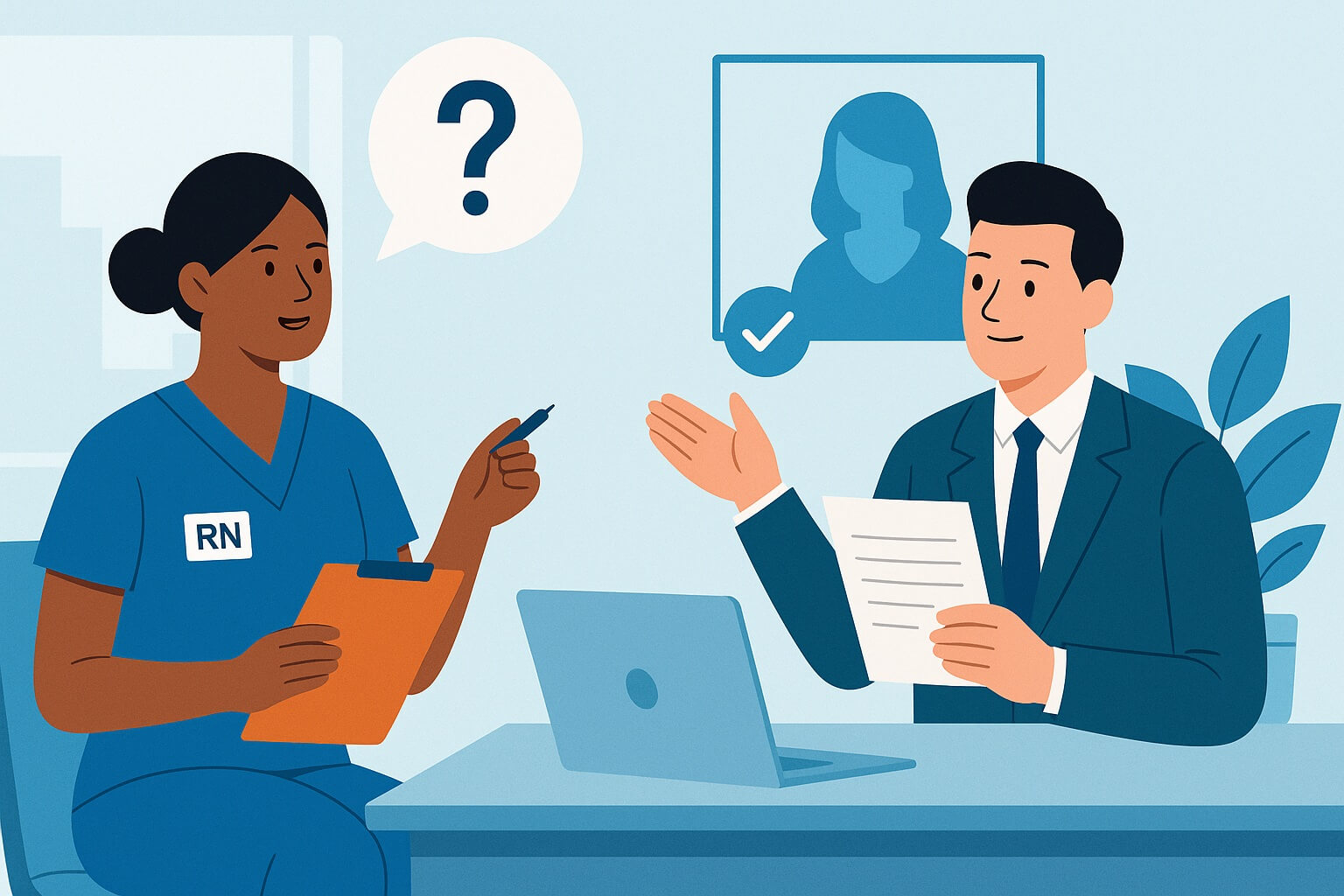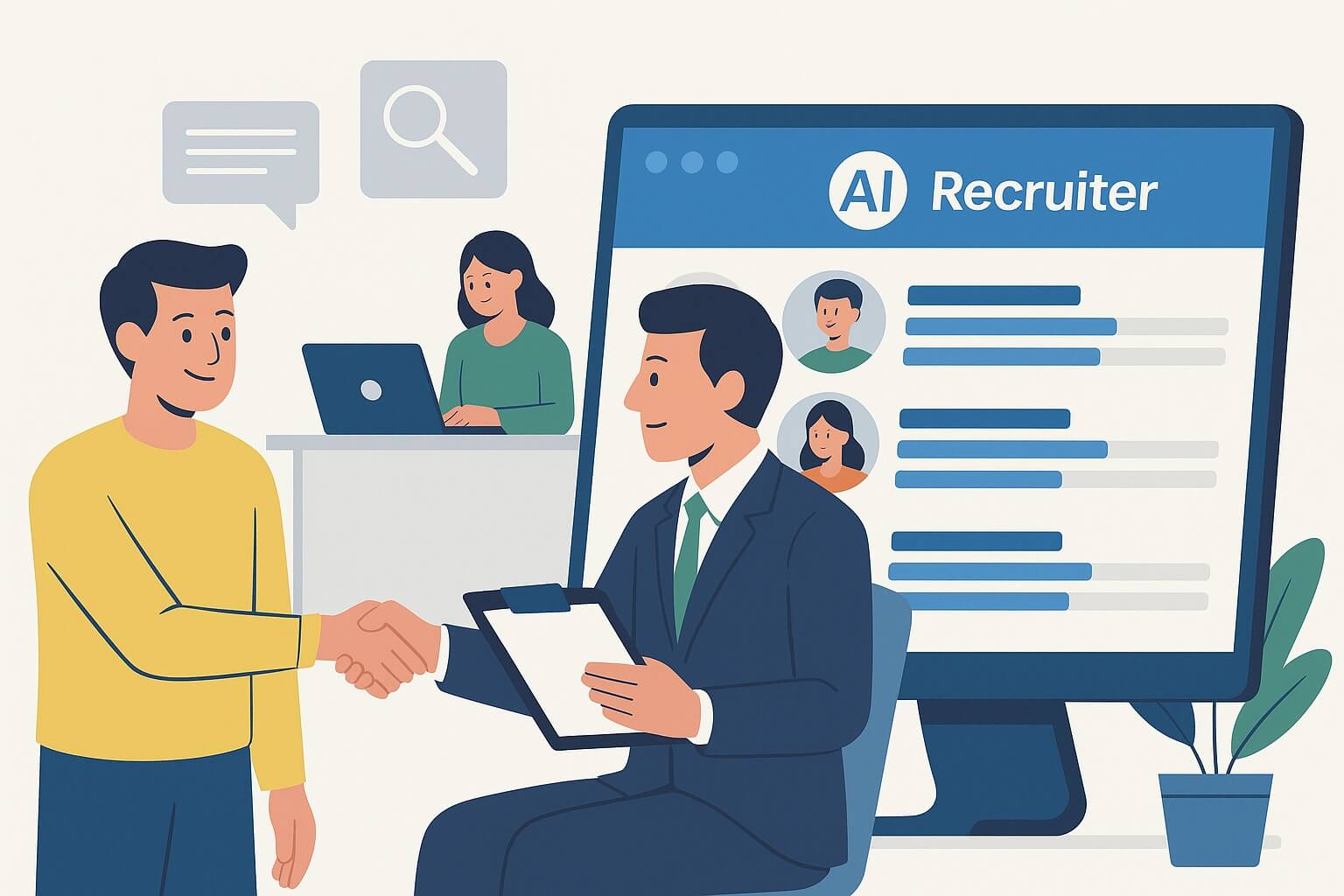Learn how to use AI in recruiting to screen resumes faster, detect fake applications, improve interviews, reduce bias, and fill roles in less time. This guide shows how TA leaders can transform hiring with practical AI workflows.
TL;DR
- AI in recruiting handles resume screening, assessments, scheduling, and engagement so you can focus on interviews and decision-making.
- It helps reduce time-to-hire, improves candidate quality, and lowers cost-per-hire across high-volume and recurring roles.
- Modern AI tools can detect AI-written resumes, inconsistencies, and scripted interview responses to safeguard hiring integrity.
- AI recruiting works best when integrated with your existing ATS or HCM to enhance—not replace—your current workflow.
- AI reduces human bias by applying consistent evaluation criteria based on skills, experience, and performance potential.
- You should start small with one pain point, prove value, measure results, and then scale across your recruitment process.
- CloudApper AI Recruiter brings all these capabilities together and integrates seamlessly with platforms like UKG, Workday, SAP, and Oracle.
Table of Contents
Let me be honest with you first. If you’re still manually screening hundreds of resumes every week and constantly juggling between whether you should start researching how to use AI in recruiting top talent or not, your competitors are already two steps ahead.

For more information on CloudApper AI Recruiter visit our page here.
I’ve worked with countless TA leaders who started exactly where you are right now. They were drowning in applications, losing top candidates to faster competitors, and watching their recruiting budgets balloon with each open position. The good news? AI transformed their entire hiring process. And it can do the same for you. In this article, I’ve summed up everything you should know as a talent acquisition leader about using AI in your hiring process, so that you can finally make an informed decision.
What Is AI Recruiting (And Why Should You Care)?
AI recruiting means using artificial intelligence to handle the repetitive, time-consuming parts of hiring while you focus on what actually matters: building relationships with the right candidates.
Think of AI as your tireless assistant who never sleeps, never gets overwhelmed, and processes information faster than any human team could. It screens resumes, schedules interviews, engages candidates, and helps you make data-driven decisions.
But here’s what most people get wrong. AI isn’t here to replace you or your recruiting team. It’s here to make you better at your job.
According to a recent study, 86.1% of recruiters utilizing AI reported that it accelerates the hiring process. [1]
The Real Business Case for AI in Recruiting
You’re probably thinking about ROI right now. Let me give you the numbers that matter.
AI recruitment reduces cost-per-hire by as much as 30% [2]. For a company hiring 100 people a year at an average cost of $4,700 per hire, that’s $141,000 in savings annually. And that’s just the direct cost reduction.
The real value comes from what happens after you implement AI:
Speed: Successful AI recruitment implementation can deliver up to 97% reduction in time-to-hire through automation and parallel processing. When you use AI in recruiting effectively, your competitors take 45 days to fill a role; watch you do it in 2.
Quality: 43% of recruiting firms report a higher quality of hire when using AI tools [3]. Better candidates mean lower turnover, higher performance, and stronger teams.
Scale: AI provides 10x candidate processing capacity, enabling access to broader talent pools. You can now consider candidates you would have never had time to review manually.
Retention: Organizations see significant improvement in retention rates through better candidate-role matching. When AI helps you find the right fit from the start, people stay longer.
How AI in Recruiting Actually Works
Let me walk you through exactly how AI transforms each stage of your hiring funnel. I’m not going to give you a theory. I’m going to show you the practical applications that work right now.
Sourcing: Finding Candidates You Didn’t Know Existed
Traditional sourcing is like fishing with a single line. AI in recruiting is like having a smart net that knows exactly which fish you want and brings them straight to you.
AI-powered candidate sourcing tools scan millions of profiles across job boards, social media, and professional networks. They identify passive candidates who aren’t actively looking but match your requirements perfectly.
Here’s what this looks like in practice. You post a job for a senior data scientist. Instead of waiting for applications, your AI tool:
- Searches LinkedIn, GitHub, and industry forums for profiles matching your criteria, or integrates with your existing ATS and sources candidates directly from them
- Analyzes skills, experience, and career trajectory
- Identifies candidates who are likely open to new opportunities based on their activity patterns
- Automatically ranks them by fit
You’re not just casting a wider net. You’re casting a smarter net.
Resume Screening: Stop Wasting Hours on Unqualified Candidates
This is where most TA leaders first see the magic of AI in recruiting talent. And for good reason.
85% Organizations report a reduction in screening time [4]. Think about what that means for your team. AI resume screening tools analyze resumes in seconds. They look at:
- Skills and qualifications match
- Years of relevant experience
- Educational background
- Career progression patterns
- Keywords and competencies
But here’s the key difference from basic keyword matching. Modern AI recruiting tools like CloudApper AI Recruiter understand context. It knows that “led a team of 5 engineers” means management experience, even if the resume doesn’t explicitly say “management skills.”
You can learn more about optimizing this process in our guide on AI resume screening and how to shortlist candidates fast with AI.
Candidate Assessment: Beyond the Resume
Resumes tell you what candidates say they can do. Assessments show you what they actually can do. This is another area where using AI in recruiting delivers measurable results.
AI-powered assessment tools evaluate:
- Technical skills through coding challenges or job simulations
- Soft skills through behavioral assessments
- Cultural fit through values alignment questions
- Communication abilities through written or video responses
The AI learns from your best performers and identifies candidates with similar traits and capabilities. This is particularly valuable for high-volume hiring where you need to assess hundreds of candidates quickly. Check out our detailed post on candidate screening with AI in Workday ATS to see how this works within your existing systems.
For evaluating non-technical abilities, read our guide on AI in soft skill assessment and skill assessment with AI.
Detecting AI-Written Resumes and Interview Cheating
AI tools have made it easy for candidates to generate polished resumes or prepare scripted interview answers. I’ve seen resumes that look perfect but don’t hold up when questions go deeper. Modern recruiting AI helps you spot this early by analyzing writing patterns, tone, and phrasing to detect AI-generated resumes or suspicious inconsistencies.
CloudApper AI Recruiter also helps during interviews. It tracks response patterns, compares answers with the resume, and flags potential coaching or scripted replies. It can even generate follow-up questions on the spot to test real problem-solving, making it harder for candidates to rely on memorized responses.
The goal isn’t to penalize candidates. It’s to give recruiters clarity on genuine experience versus rehearsed content. In a market where AI can create resumes in seconds, you need AI to help verify what’s real.
For more detailed information, read our guide on how to design a fraud-resistant recruitment process and how to detect live interview assistants.
Interview Scheduling: End the Email Tennis
Interview scheduling shouldn’t take 2-3 hours per candidate. But it does when you’re coordinating between 4 people across different time zones.
AI scheduling tools access everyone’s calendars, identify available slots, and let candidates book directly. The entire process takes minutes instead of days. 62% of organizations use chatbots for interview scheduling [5].
The candidate gets a link, sees all available times, picks one that works, and the interview is scheduled. Your team gets calendar invites automatically. No back-and-forth emails. No double bookings. No confusion.
CloudApper AI Recruiter’s AI interview scheduling feature has saved our customers thousands of hours.
One TA director told me they recovered 15 hours per week just from automated scheduling.
Candidate Engagement: Keep Top Talent Interested
Here’s a problem you know too well. You find a perfect candidate, but your process takes 3 weeks, and they accept another offer before you can even schedule a final interview. AI recruitment chatbots keep candidates engaged throughout your hiring process by:
- Answering questions 24/7
- Providing application status updates
- Sending interview reminders and preparation tips
- Collecting additional information when needed
The key is responsiveness. When a candidate has a question at 10 PM, they don’t want to wait until your team is back in the office. The AI chatbot answers immediately, keeping them engaged and interested.
Read our guide on boosting candidate engagement with AI for more information.
Removing Bias: Fairer Hiring Decisions
Let’s talk about something critical. Unconscious bias affects every human decision, including hiring. We gravitate toward candidates who remind us of ourselves or our best performers. We judge resumes differently based on names, schools, or gaps in employment.
AI, when properly designed and monitored, can reduce this bias significantly. 43% of companies cite the reduction of human bias as a key advantage of AI. [6]
AI evaluates candidates based on objective criteria you define. It doesn’t care about:
- Names that indicate gender or ethnicity
- Where someone went to school
- Career gaps (unless you specifically program this as relevant)
- Age indicators
What it cares about:
- Skills match
- Experience relevance
- Performance potential
- Job requirements alignment
Read our comprehensive guide on how AI can remove bias from the recruitment process and bias-free, compliant hiring using AI.
Decision Making: Data Over Gut Feelings
You’ve probably heard hiring managers say, “I just have a good feeling about this candidate.” Gut feelings have their place, but they shouldn’t be your primary decision-making tool.
AI provides data-driven insights:
- Candidate scoring based on multiple criteria
- Comparison charts showing how candidates stack up
- Predictive analytics on likely performance and retention
- Historical data on similar hires and their outcomes
When you combine human judgment with AI insights, you make better hiring decisions.
Read our blog on data-driven recruitment to learn more about it.
Already seeing where AI could save you hours every week? Let me show you how it works in your hiring process.
The Parts of Recruiting Where AI Shines Brightest
Not every recruiting task needs AI. Let me tell you where using AI in recruiting delivers the most value:
High-Volume Hiring
If you’re hiring for retail, customer service, or warehouse positions where you need to process 500+ applications per role, AI is non-negotiable.
CloudApper AI Recruiter was built specifically for this challenge. It automatically screens thousands of applications, scores candidates based on your criteria, ranks them by fit, and delivers you a shortlist of the top candidates. What used to take your team days now takes hours.
Learn more in our post about handling resume screening with a high volume of applications and AI in high-volume recruiting.
Repetitive Roles
When you’re hiring for the same position repeatedly (sales reps, software engineers, nurses), AI learns what “good” looks like and replicates that evaluation at scale.
Passive Candidate Outreach
Finding and engaging passive candidates is time-intensive. AI handles the heavy lifting of identification and initial outreach, then hands off warm leads to your recruiters. Many companies see this as one of the best ways to use AI in recruiting.
Interview Preparation and Analysis
AI can help both candidates and interviewers prepare. It provides candidates with company information and role details. It gives interviewers suggested questions based on the role and the candidate’s background. Some advanced tools even analyze interview recordings to identify strong responses and areas of concern.
Common Mistakes (And How to Avoid Them)
I’ve seen companies waste hundreds of thousands on AI implementations that failed. Here are the mistakes you need to avoid.
Mistake 1: Treating AI as a Complete Solution
AI is a tool, not a magic wand. You still need human recruiters to build relationships, assess cultural fit, negotiate offers, and handle the human elements of hiring.
The key to using AI in recruiting successfully is finding the right balance between automation and human touch. Companies that succeed with AI use it to handle repetitive tasks while freeing recruiters to focus on high-value activities like stakeholder management, candidate experience, and strategic workforce planning.
Mistake 2: Poor Data Quality
AI is only as good as the data you feed it. If your job descriptions are vague, your candidate profiles are incomplete, or your historical hiring data is inconsistent, your AI will produce poor results.
Before implementing AI, clean your data. Standardize job descriptions. Document what “good” looks like for each role. Define clear evaluation criteria.
Mistake 3: Ignoring the Candidate Experience
If you don’t communicate clearly about how you’re using AI, candidates will be skeptical and potentially deterred.
Be transparent. Tell candidates that AI is screening resumes to ensure fair evaluation. Explain that humans make all final decisions. Provide ways for candidates to ask questions or flag concerns.
Mistake 4: Set It and Forget It
AI models need ongoing monitoring and refinement. What worked six months ago might not work today as your hiring needs evolve, market conditions change, or new biases emerge.
Schedule quarterly reviews of your AI performance. Look at:
- Are you hiring quality candidates?
- Is time-to-hire improving?
- Are diverse candidates progressing through your funnel?
- What feedback are candidates giving?
- Are there patterns in who the AI rejects?
Mistake 5: Trying to Do Everything at Once
Don’t try to implement AI across your entire recruiting process on day one. Start with one pain point, prove the value, then expand.
Most successful implementations start with resume screening because it delivers quick wins and builds organizational buy-in. Once your team sees the time savings and quality improvements, expanding to other areas becomes much easier.
How to Actually Implement AI in Your Recruiting Process
Let me give you a practical roadmap based on implementations I’ve guided personally.
Step 1: Identify Your Biggest Pain Point
Where is your team spending the most time? Where are you losing the best candidates? What’s costing you the most money?
For most organizations, it’s one of these:
- Too many applications to screen manually
- Interview scheduling chaos
- Slow time-to-hire, losing top candidates
- Inconsistent candidate evaluation
- Poor candidate experience
Pick one. Don’t try to solve everything.
Step 2: Define Success Metrics
How will you know if AI is working? Define specific, measurable goals:
- Reduce time-to-hire from 45 days to 25 days
- Cut screening time from 20 hours per week to 5 hours
- Increase candidate quality scores by 30%
- Improve diversity in your candidate pipeline by 20%
- Reduce cost-per-hire by $1,500
Whatever you choose, make it specific and measurable.
Step 3: Choose the Right Tool
Not all AI recruiting tools are created equal. Look for:
Integration: Does it work with your existing ATS and HRIS? CloudApper AI Recruiter integrates seamlessly with major systems like Workday, SAP SuccessFactors, Oracle, UKG, and many others. No messy migrations or workflow disruptions.
Customization: Can you tailor it to your specific needs? You should be able to define your evaluation criteria, customize questions, and adjust scoring algorithms. CloudApper AI Recruiter can be customized based on your specific recruitment needs.
Transparency: Can you understand how it’s making decisions? Black box AI creates compliance risks and erodes trust.
Support: Does the vendor provide implementation support and ongoing training? For any kind of support, the CloudApper AI team is always there for you.
Bias Monitoring: Does it include tools to detect and prevent bias?
Step 4: Start Small, Prove Value, Scale Fast
Implement AI for one role or one department first. Measure everything. Document time savings, quality improvements, and cost reductions.
Use these results to build your business case for broader implementation. Most executives are skeptical of AI until they see concrete ROI. Give them numbers they can’t argue with.
Step 5: Train Your Team
Your recruiters need to understand:
- How the AI works
- What it can and cannot do
- How to interpret its recommendations
- When to override its suggestions
- How to identify potential bias
This isn’t optional. Untrained teams either misuse AI or don’t use it at all.
Step 6: Communicate with Candidates
Update your job postings, career page, and application process to explain how you use AI. Something like:
“We use AI-powered tools to ensure every application receives fair and consistent evaluation. All hiring decisions are made by humans who review AI recommendations along with other factors.”
Transparency builds trust.
If you already know your biggest pain point, this is the right moment to test a pilot.
The Benefits You’ll Actually See
Let me be specific about what changes when you implement AI recruiting properly and truly understand how to use AI in recruiting effectively.
Your Team’s Day-to-Day
Your recruiters stop drowning in administrative work. Instead of spending 70% of their time on screening, scheduling, and data entry, they spend 70% on candidate relationships, stakeholder management, and strategic planning.
Your Time-to-Hire
You fill positions faster. While that’s an exceptional result, even modest improvements give you a competitive advantage.
When your competitors take 6 weeks to make an offer, you’re making offers in 2 weeks. You win the top candidates.
Your Hiring Quality
You make better hiring decisions because you’re evaluating more candidates more consistently. AI-driven processes have led to a 24% improvement in candidate quality.
Your Budget
Lower cost-per-hire, less reliance on expensive recruiting agencies, and better retention all contribute to significant savings.
Organizations implementing comprehensive AI recruitment platforms report average cost savings of $2.3M annually for enterprises with 1000+ employees. [7]
Your Diversity
When implemented correctly, AI improves diversity outcomes. By eliminating human bias from initial screening, you ensure qualified, diverse candidates aren’t filtered out before humans ever see them.
Your Candidate Experience
Faster responses, clearer communication, and more consistent processes all improve how candidates perceive your company. Even candidates you don’t hire will have a better experience, protecting your employer brand.
How CloudApper AI Recruiter Puts It All Together
Let me show you how this works in practice with our platform.
You have 500 applications for an operations manager role. Here’s what happens when you implement CloudApper AI Recruiter into your hiring process:
Step 1: Instant Screening CloudApper AI Recruiter screens all 500 resumes in minutes. It evaluates each against your specific criteria (years of experience, required skills, relevant industry background, management experience).
Step 2: Intelligent Scoring Every candidate gets a score based on fit. The AI identifies your top 50 candidates and ranks them. You can see exactly why each candidate scored as they did.
Step 3: Automated Assessment Your top 50 candidates automatically receive a personalized assessment. This might include scenario-based questions, skill evaluations, or video responses. The AI scores their responses and updates their ranking.
Step 4: Candidate Engagement While you’re reviewing top candidates, the AI chatbot keeps everyone engaged. It answers questions, provides updates, and collects additional information when needed.
Step 5: One-Click Scheduling You decide to interview the top 10 candidates. Click a button, and the AI schedules all 10 interviews by coordinating with your hiring team’s calendars and giving candidates self-serve scheduling options.
Step 6: Interview Insights After interviews, the AI compiles all information: resume data, assessment results, interview notes, and scoring. You get a comprehensive view of each candidate to make informed decisions.
Step 7: Offer Management When you select your finalist, the AI generates the offer letter, tracks acceptance, and initiates onboarding workflows.
Total time your team spent: About 5 hours to review top candidates and conduct interviews.
Time saved: Approximately 35 hours compared to manual processing.
This is what we mean by AI recruiting. It’s not about replacing your judgment. It’s about giving you the time and information to make better decisions.
Your Next Steps: Getting Started with Using AI in Recruiting
You’ve read the guide. You understand the potential. Now what?
This Week
- Identify your biggest pain point. Where is recruiting causing the most problems right now? High-volume roles taking too long? Quality issues? Candidate drop-off?
- Gather baseline data. How long does it currently take to fill positions? What’s your cost-per-hire? How many hours does your team spend on screening?
- Talk to your team. What are your recruiters’ biggest frustrations? Where do they see the most opportunity for improvement?
This Month
- Research solutions. Look at AI recruiting platforms that address your specific pain point. Or contact us and request a quick demo where we’ll show you how you can enhance your recruitment process with CloudApper AI Recruiter.
- Build your business case. Calculate potential ROI. If you can cut time-to-hire by 60% and reduce cost-per-hire by $1,500, what does that mean annually?
- Start small. Choose one role or department for a pilot. Make it something high-volume where you’ll see quick results.
This Quarter
- Implement your pilot. Work closely with your chosen vendor. Make sure your team is properly trained.
- Measure everything. Track time-to-hire, cost-per-hire, candidate quality, diversity metrics, and team satisfaction.
- Document your results. Build a case study showing the impact. Use this to secure buy-in for broader implementation.
Looking Ahead
The AI recruiting market is growing fast. The AI recruitment market stood at USD 596.16 million in 2025 and is forecast to reach USD 860.96 million by 2030. [8]
This growth means more investment, better tools, and increased capabilities. The question isn’t whether AI will transform recruiting. It’s whether you’ll be leading that transformation or scrambling to catch up.
Companies that embrace AI recruiting now will have a massive competitive advantage. They’ll hire faster, cheaper, and better than competitors still using manual processes. They’ll build stronger teams, improve retention, and reduce costs.
The Bottom Line
AI recruiting isn’t about replacing human recruiters. It’s about making them superhuman. When you know how to use AI in recruiting properly, you transform your entire talent acquisition function.
It handles the repetitive work so your team can focus on relationships, strategy, and the human elements of hiring that actually differentiate great recruiting from mediocre recruiting.
You’ll hire faster. You’ll hire better. You’ll spend less. And your team will actually enjoy their work instead of drowning in administrative tasks.
The companies I’ve worked with see results within weeks. One TA director told me “I got my life back.” Another said “We’re actually excited about hiring again instead of dreading it.”
That’s what AI recruiting delivers when you do it right.
If you want to see exactly how CloudApper AI Recruiter can transform your hiring process, schedule a demo with our team. We’ll show you the platform, discuss your specific challenges, and build a customized implementation plan.
The future of recruiting is here. Are you ready to embrace it?
Want to learn more? Check out our comprehensive guide on the benefits of using AI in recruitment process and explore how candidate shortlisting with AI can transform your hiring outcomes.
AI recruiting doesn’t replace your team. It gives them their time back. Ready to see it?
Reference:
- https://www.zippia.com/employer/ai-recruitment-statistics/
- https://www.demandsage.com/ai-recruitment-statistics/
- https://www.apollotechnical.com/statistics-on-ai-in-recruiting/
- https://www.shrm.org/labs/resources/the-evolving-role-of-ai-in-recruitment-and-retention
- https://www.secondtalent.com/resources/ai-in-recruitment-statistics/
- https://www.demandsage.com/ai-recruitment-statistics/#:~:text=Additionally%2C%2043%25%20of%20those%20surveyed%20noted%20that%20AI%20could%20help%20eliminate%20human%20biases%20from%20the%20hiring%20process.%C2%A0
- https://www.secondtalent.com/resources/ai-in-recruitment-statistics/#:~:text=Organizations%20implementing%20comprehensive%20AI%20recruitment%20platforms%20report%20average%20cost%20savings%20of%20%242.3M%20annually%20for%20enterprises%20with%201000%2B%20employees.
- https://www.mordorintelligence.com/industry-reports/ai-recruitment-market

Reduce Time-to-Hire by 97% with AI for Talent Acquisition
Recruit skilled, culturally fit, and diverse candidates with CloudApper’s state-of-the-art AI resume screening, automated interview scheduling, and offer letter generation.
Learn more | Download BrochureQuestions I Get Asked The Most
-
What does “using AI in recruiting” actually mean?
Using AI in recruiting means applying artificial intelligence to handle repetitive tasks such as sourcing, resume screening, assessments, scheduling, and candidate engagement so your team can focus on interviews, relationships, and strategic hiring decisions. -
How can AI improve my time-to-hire?
AI speeds up time-to-hire by instantly screening resumes, ranking candidates by fit, automating assessments, and handling interview scheduling. This removes bottlenecks that usually slow down your process, so you can move top candidates through the funnel much faster. -
Can AI really detect fake or AI-written resumes?
Yes. Modern AI recruiting tools can analyze writing style, phrasing patterns, and inconsistencies to flag resumes that look generated or heavily coached. This helps you prioritize candidates with genuine experience and dig deeper when something feels “too perfect.” -
How does AI help during live interviews?
AI interview assistants can suggest questions, track response patterns, compare answers with the resume, and flag potential scripted or inconsistent replies. They also help you keep interviews structured and fair across all candidates. -
Will AI replace recruiters in the future?
No. AI is designed to support recruiters, not replace them. It handles admin-heavy work like screening, scheduling, and reminders while recruiters focus on evaluating fit, building relationships, advising hiring managers, and improving the overall talent strategy. -
How does AI reduce bias in hiring?
AI can apply consistent evaluation criteria across all candidates, focusing on skills, experience, and performance indicators instead of names, schools, or other bias triggers. When monitored and tuned correctly, this leads to fairer and more inclusive hiring decisions. -
Where should I start if I am new to AI in recruiting?
Start with one high-impact area such as resume screening or interview scheduling. Define clear success metrics, run a pilot for a specific role or department, measure results, then expand to other parts of your recruiting process once you see value. -
How does CloudApper AI Recruiter fit into my existing ATS or HCM?
CloudApper AI Recruiter integrates with major ATS and HCM platforms so you do not need to replace your current systems. It adds an AI layer on top that handles screening, assessments, engagement, and scheduling while your ATS remains the system of record.
What is CloudApper AI Platform?
CloudApper AI is an advanced platform that enables organizations to integrate AI into their existing enterprise systems effortlessly, without the need for technical expertise, costly development, or upgrading the underlying infrastructure. By transforming legacy systems into AI-capable solutions, CloudApper allows companies to harness the power of Generative AI quickly and efficiently. This approach has been successfully implemented with leading systems like UKG, Workday, Oracle, Paradox, Amazon AWS Bedrock and can be applied across various industries, helping businesses enhance productivity, automate processes, and gain deeper insights without the usual complexities. With CloudApper AI, you can start experiencing the transformative benefits of AI today. Learn More

CloudApper AI Solutions for HR



- Works with
- and more.
Similar Posts

10 Essential Registered Nurse (RN) Interview Questions to Ask (And…

What Is An AI Recruiter? Everything You Need to Know
















